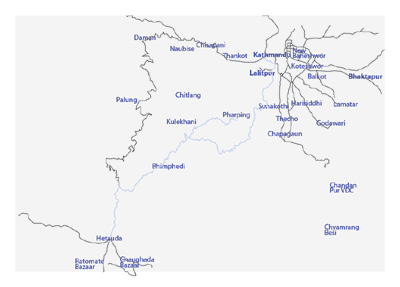 Talk of building a fast track road from the terai into Kathmandu has been going on for ever, it seems. In 1850 Prime Minister Jung Bahadur Rana made the historic trip to England and then on the way back stopped in Ceylon (Sri Lanka). The son of the then Chief Justice of Ceylon, Laurence Oliphant accompanied the Nepali entourage on the way back to Kathmandu. Laurence wrote a detailed account of the journey including the portion that is still talked about as the “future fast track” to Kathmandu. The book, A Journey to Kathmandu with the Camp of Jung Bahadoor by Laurence Oliphant, was first published in London in 1852.
Talk of building a fast track road from the terai into Kathmandu has been going on for ever, it seems. In 1850 Prime Minister Jung Bahadur Rana made the historic trip to England and then on the way back stopped in Ceylon (Sri Lanka). The son of the then Chief Justice of Ceylon, Laurence Oliphant accompanied the Nepali entourage on the way back to Kathmandu. Laurence wrote a detailed account of the journey including the portion that is still talked about as the “future fast track” to Kathmandu. The book, A Journey to Kathmandu with the Camp of Jung Bahadoor by Laurence Oliphant, was first published in London in 1852.
His observations in the 1850s may help us understand the reason why we still have to go west from Kathmandu for 110 kilometers before turning south, and then east again to get to Hetauda; or take the winding 133 kilometers long Tribhuvan Rajpath to this day instead of the “fast track”. There is a section in the book where Laurence describes the 18 miles section of the road between Hetauda and Bhimphedi which he felt
“….might be much improved by a little engineering”.
He goes on to write, “The present policy of the Nepaul government is to keep the roads by which their country is approached in as impassable a state as possible, vainly imagining that in case of war, the badness of the roads would offer an insuperable obstacle to our progress and compel us to relinquish any attempt to penetrate to Kathmandu. This delusion ought to have been dispelled by the occupation of Muckwanpore by Sir David Ochterlony; not that it is a contingency they need take much trouble to provide against, since it would never be worth our while to do more than take possession of the Terai.
The present state of the roads renders it impossible for goods to be conveyed into Nepaul except upon men’s backs; and as the traffic would be considerable in various articles of commerce, the prosperity and wealth of the country would be incalculably increased by an improvement in the means of transit….”
This was published in 1852. This time i.e. 2011 the private sector wants to take the lead and is partnering with over 21 Village Development Committees that are enroute to build the four lane fast track that will take an hour to get us to Hetauda. The distance between the two cities is only 37 kilometers as the crow flies, but the road design is going to be around 50 kilometers with a long tunnel near Bhimphedi. The promoters also tell us that the area in between has possibilities for satellite settlements that will help ease some of the pressure off Kathmandu.
As USAID celebrates 60 years in Nepal, it way well be worth noting that the two cities were linked by a ropeway for many decades. The ropeway is one of many infrastructures the US tax payer has gifted to Nepal over the last six decades. You can see the remains of it at Teku next to the remains of the German funded waste management plant.
Nepal has remained a sovereign country throughout history and this is a definite non-negotiable. We do however need to get the people out of poverty and help each of them to realize their full potential. We need to take advantage of the economic boom in our neighborhood while ensuring we do not lose out on any of our values. The trade between India and China has exceeded fifty billion dollars. We need to be part of this new economy.

Massage Away your Stress
A Five Thousand-Year-old Ayurvedic massage helps you de-stress from your hectic life. Life brings in a lot...









